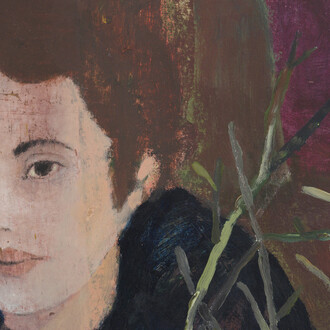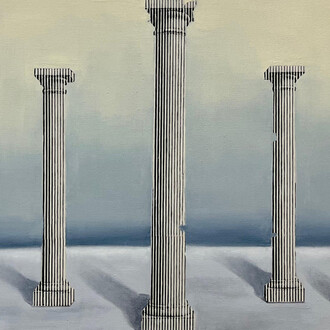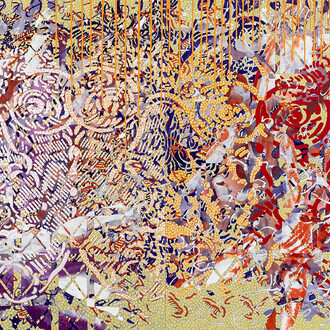We enter through a portal (Five swords and a bow, 2025). Arrows and daggers have rained down on the walls of the corridor. Polished using the lucidare specchio technique (‘mirror of light’), these bronze weapons birthed from a war without warriors, have now half disappeared. As one approaches, scratches can be seen on the metal, bearing witness to a past of muted violence.
Pointing outwards, the arrows open a breach into the world of Apollinaria Broche. A dark place, where flowers and shadows grow human souls.
On the first floor of Galerie Hussenot, the first two pieces on the initiatory journey transport us into another world. Shadow, mouvement, portal (2025), an upside-down shadow girl, acts as a physical and metaphysical bridge between the real and the unconscious. The black sulfide that covers her creates a play of light that sets her in motion; sculpted in bronze, we think her immutable, but she already escapes us. Her feet become brambles, and the silver nitrate in which she has been immersed gives her a spectral transparency: she has already passed to the other side.
The girl acts as a doorway to the house (Another point of reference, 2025), still too small to be inhabited. Suspended upside down by fine, precious threads, this point of reference is untouchable and cannot be damaged. It is a goal to be reached, distant, under construction, and fragile. No matter. For in waiting for a room of its own, the shadow has gone ahead of its body and managed a way ‘to find its dimensions, not be impeded’1. So, beneath the house's foundations, Apollinaria Broche engraves a prophetic inscription: ‘Home again, I know one day I'll find my home’. And at its heart, she plants a white bronze tree as an omen of things to come.
Upstairs, the artist continues to cultivate her garden, from which flowers spring forth with each exhibit. For The unspoken rules of secret play, she summons three of them like the three Moirai fates, weaving a reflection on the passing of time, ever so necessary for transformation. The flowers are set against a series of tarot cards, whose omens haunt the exhibition. Eleven cards conceived as bas-reliefs in bronze and ceramics succeed to the ‘hangman’ below. Thought as display cases, the artworks contain keys, threads, spoons, preserved items collected over the years.
These works echo Sekretiki, the game of secrets Apollinaria played as a child, in which valuable objects were enclosed under glass and buried underground like space-time capsules. In Sekretiki, as in the exhibition, play and destiny are intimately linked, expressing a desire to control the hazards of life.
The first flower, Venus (2025), its stem satin-smooth like skin, is beginning an anthropomorphic transformation. Balanced on four claws, its fifth strand is a human leg clad in fishnet stockings, a molded witness to Apollinaria’s first search for sensuality. With its wide-spread white ceramic petals, Venus testifies to a liberation of the flesh through transfiguration. The second, ‘Moirai and cat's cradle* (2025), whose buds are hands in action, indicate a rediscovered mastery over destiny through the performance of play. Finally, the smaller Primavera (2025) seems to combine past and present, foreshadowing with its pale-blue crown, a discreet, gentle spring blooming, the fruit of fantasy, but a fantasy ready at last to leap into the world of reality.
Sculpted in white bronze cast around metal stems, the normally motionless flowers vibrate and play out a non-verbal dialogue with each other. An obsessive sculptor, Apollinaria is constantly in contact with matter. She ultimately makes it sensual, imbuing it with the sometimes unacknowledged desires of her body and her femininity. She achieves this through the precise work of polishing, satin-finishing and waxing, and by bringing balance and movement to the shapes that counter the immutability of bronze.
Apollinaria Broche is always at the boundary between solid cold and liquid movement. With her, the works are still-warm bodies, animated, and magical.
In limbo, Apollinaria found refuge a few years ago in a foundry, where she has merged with her works and their environment. With them, Apollinaria reshu les the cards of the secret game she's been dealt, inviting us to plunge into the heart of her volcano.
Perched with her on sharp stilts, we glimpse it in the distance: time regained.
(Text by Justine Daquin)
Notes
1 Virginia Woolf, A room of one’s own, 1929.














